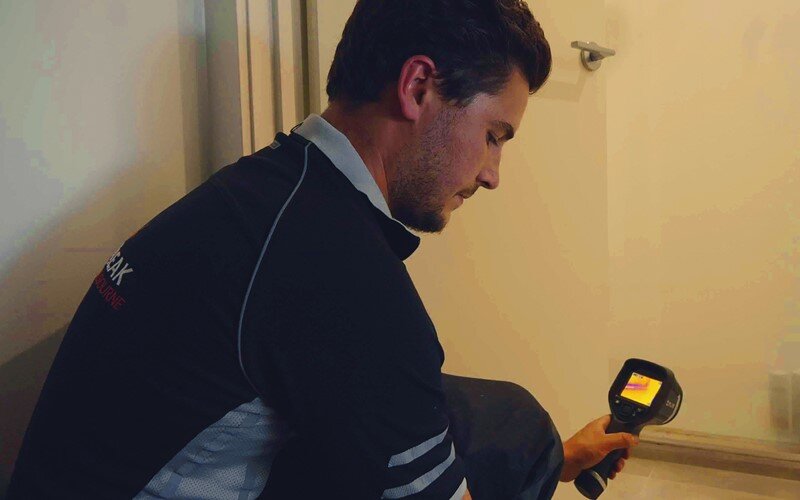How to Locate as well as Repair Work Water Leaks-- A Comprehensive Guide
How to Locate as well as Repair Work Water Leaks-- A Comprehensive Guide
Blog Article
Are you interested in details concerning Finding hidden leaks?

Early discovery of leaking water lines can reduce a potential catastrophe. In addition to conserving you money, it will certainly reduce the worry as well as aggravation. The minute you locate a leak, calling your plumber for repair work is the most effective solution. Nevertheless, some small water leaks might not show up. Right here are some hacks that help if you can not spot it with your nude eyes.
1. Analyze the Water Meter
Every house has a water meter. Examining it is a proven way that helps you uncover leaks. For starters, switch off all the water resources. Guarantee no one will certainly flush, utilize the faucet, shower, run the cleaning device or dishwasher. From there, go to the meter as well as watch if it will certainly alter. Because no one is utilizing it, there ought to be no movements. That shows a fast-moving leak if it relocates. Furthermore, if you identify no changes, wait a hr or 2 and examine back once more. This indicates you might have a sluggish leakage that can also be underground.
2. Examine Water Intake
If you spot sudden modifications, despite your consumption being the exact same, it implies that you have leakages in your plumbing system. An abrupt spike in your costs suggests a fast-moving leakage.
Meanwhile, a consistent boost monthly, despite having the same habits, reveals you have a slow-moving leak that's likewise gradually intensifying. Call a plumber to thoroughly examine your residential or commercial property, specifically if you really feel a cozy location on your flooring with piping below.
3. Do a Food Coloring Examination
When it comes to water intake, 30% comes from toilets. If the color somehow infiltrates your dish throughout that time without flushing, there's a leak between the container and also dish.
4. Asses Exterior Lines
Do not fail to remember to inspect your outdoor water lines also. Must water permeate out of the link, you have a loose rubber gasket. One tiny leak can lose heaps of water and also surge your water bill.
5. Evaluate the situation as well as check
Homeowners should make it a practice to examine under the sink counters and also inside cabinets for any bad odor or mold development. These 2 red flags show a leak so prompt interest is required. Doing regular examinations, also bi-annually, can conserve you from a significant issue.
If you understand your home is currently old, keep a careful eye on your heating systems, hoses, pipelines etc. Check for stainings and damaging as most appliances and also pipelines have a life span. They will likewise normally wear away because of tear and also use. If you suspect leaking water lines in your plumbing system, do not await it to escalate. Call an expert plumber immediately so you do not end up with a dreadful mess in your home.
Early detection of dripping water lines can mitigate a potential calamity. Some small water leakages may not be noticeable. Checking it is a surefire means that helps you discover leaks. One little leak can throw away heaps of water as well as increase your water bill.
If you believe leaking water lines in your plumbing system, do not wait for it to intensify.
How to Know If Your Home Has a Hidden Leak
Water Meter Reveals Inexplicable Water Usage
If you’d like to test whether or not there’s a leak somewhere in your home, you can do this using your water meter. Here is how to conduct the test:
Don’t use any water in your home for at least 30 minutes; this also means not turning on faucets or water-using appliances.
Go outside, and check your water meter for activity.
If your water meter shows that there was activity, even though no one was using any water, this proves that there is a leak in your home.Visible Mold or Mildew Growth
Leaks behind walls create moist, dark environments that allow mold and mildew to grow and thrive. Eventually, you might see mold growth forming on the wall closest to a hidden leak.
If mold is growing in an area that receives a high amount of moisture, such as a bathroom, it may simply be an indication that better ventilation is needed. However, if you see mold growth on a wall or the ceiling in an area where you would not expect, you probably have a hidden leak.
Musty, Mildew Odor
Sometimes you might not be able to see the mold or mildew that is growing as a result of a leak. However, the smell can give the problem away just as easily. If you catch a whiff of something musty, there’s a good chance that old water is collecting somewhere in your home that you can’t see.
Stained/Warped Walls, Ceilings, or Floors
When your home soaks up water, a variety of red flags can become visible, including ceiling stains, bubbling drywall, warped walls, and sagging floors. While these issues can be caused by excess humidity, they can also be signs that a pipe or plumbing connection has started leaking behind your walls.
Inexplicably High Water Bill
After a while, you get a general sense for what your water bill should be. If you own a pool or sprinkler system, your bill will tend to be higher during summer. However, if you receive a water bill that seems especially high, and you can’t figure out what caused it, then you may have a hidden leak somewhere that’s increasing your bill.
https://www.plumbingjoint.com/blog/2019/july/how-to-know-if-your-home-has-a-hidden-leak/

As a passionate person who reads on Top leak detection hacks, I was thinking sharing that piece of writing was beneficial. Sharing is nice. One never knows, you could be doing someone a favor. Thanks for your time. Visit again soon.
Report this page